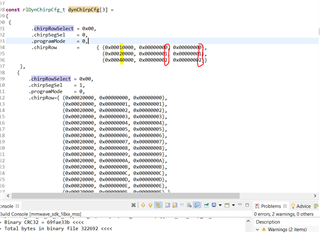Hi,
Regarding dynamic configuration, there are two types :
- First type involves stop/restart the sensor. In this mode the chirp/profile config can be updated.
-The second type allows to dynamically re-configure some parameters without stop/restart sensor.
I'm using an mmwave radar AWR1843 with OOB demo. So I tried to implement a code to achieve the second type and it works.
My question is how to change the rlChirpRow_t params :
From what I see in the example below: the varailbe in yellow are TX enabled TX1 tx2 TX3 and what is in red are chirpstartinx and chirpenindx but I want to know how to change the other parameters in rlChirpRow_t like profileidx, variation of start frequency, variation of frequency slope, variation of idle time, and variation of ADC start time How can I modify rlChirpRow_t values to get the other parameters I want.

I saw the comment and description of rlChirpRow_t but I didn't get it very well. Could someone help me with an example or something like that?
Thank you,
Ben Hassine.

